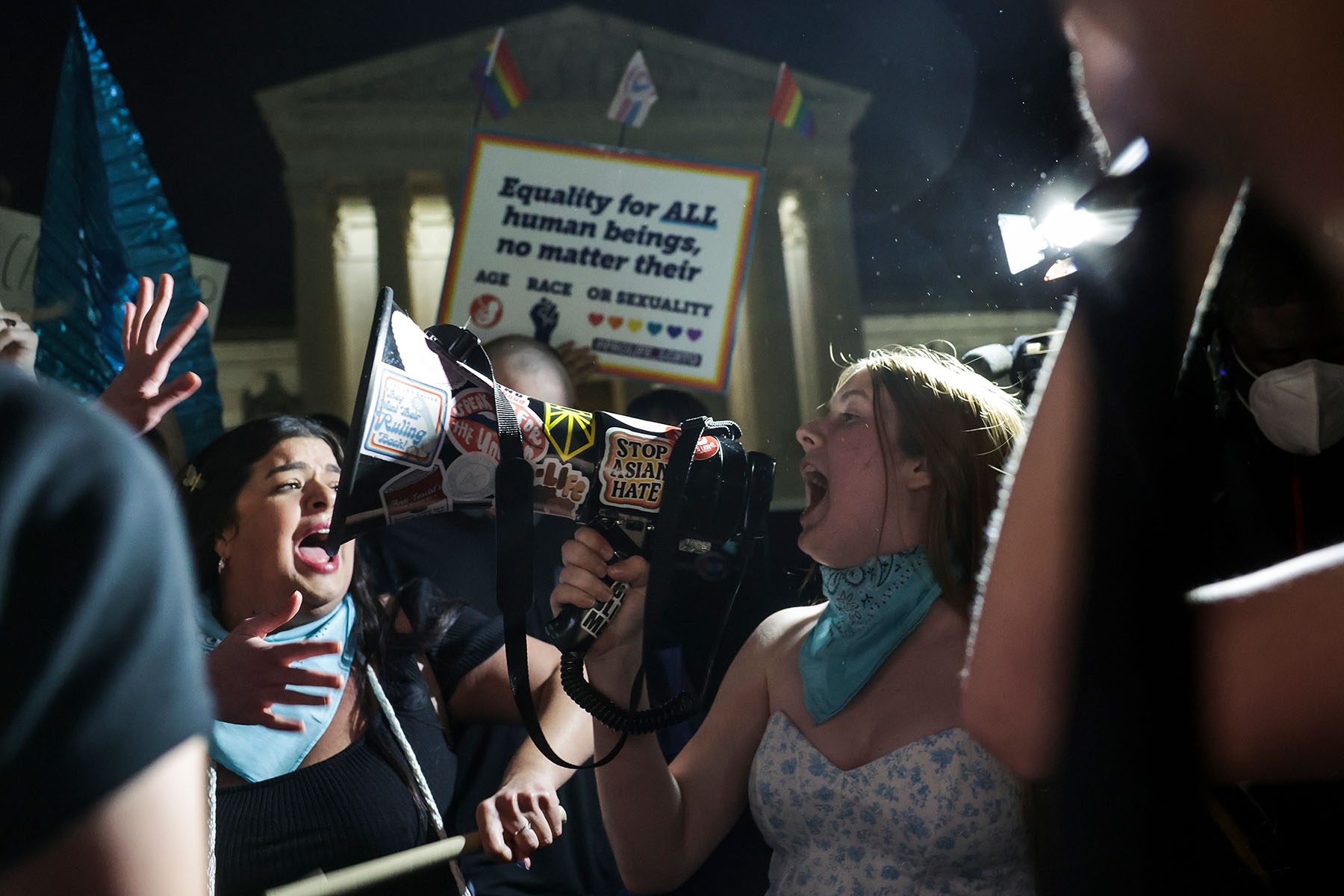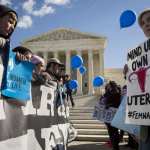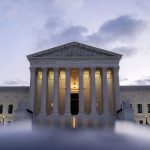This developing story is being updated.
On Monday night, Politico reported that Roe v. Wade — the 1973 decision that enshrined federal abortion protections — will be overturned, according to an initial draft authored by Justice Samuel Alito. The decision, related to Dobbs v. Jackson Women’s Health Organization, was expected this summer. Politico obtained an early draft circulated among the court.
With Roe overturned, the level of abortion access — or even if the procedure is legal at all — will be left to the states. For months, in anticipation of the decision being overturned or weakened by the Supreme Court, Republican-led states have been passing new abortion restrictions that clearly violated the court precedent.
Here is what we know about the decision and what abortion access will look like in key states.
What do we know about what the Supreme Court will do — and when?
Alito’s draft opinion obtained by Politico was clear in its interpretation: “We hold that Roe and [Planned Parenthood v.] Casey must be overruled.”
However, it is unclear if this is what the final decision, expected to be released this summer, will say.
So what happens if the Supreme Court rules like this?
If the Supreme Court knocks down Roe v. Wade, the legality of abortion will be left up to the states, meaning abortion access is completely dependent on where a person lives. For months, Republican-led states have been passing abortion restrictions that clearly violated Roe v. Wade in anticipation of the decision.
Roe protected the right to an abortion up until fetal viability. Now, if Roe is overturned, states will be able to outlaw abortion at any point in a pregnancy — or completely.
“It is time to heed the Constitution and return the issue of abortion to the people’s elected representatives,” Alito wrote in the draft opinion.
Is abortion still protected in the United States?
The draft opinion was obtained by Politico, but has not been handed down. As of yet, the Supreme Court has not overturned Roe v. Wade, which ensures that abortion is protected to the point of fetal viability. Nothing will immediately change until the court hands down its decision.
What case is this related to?
In December, the Supreme Court heard arguments in the case Dobbs v. Jackson Women’s Health Organization over a Mississippi law that banned abortion after 15 weeks, which violated the fetal viability standard.
What are the two Supreme Court cases that currently determine abortion rights?
Roe v. Wade, decided in 1973, held that the Constitution guaranteed a right to an abortion until a fetus could live independently outside the womb, a limit that has been put at about 22 to 24 weeks of pregnancy. In 1992, the high court ruled in Planned Parenthood v. Casey that states could restrict access as long as they did not impose an “undue burden” on people looking to end a pregnancy.
Can the Supreme Court undo those previous decisions?
Generally courts rely on previous decisions, a principle known as “stare decisis.” But the Supreme Court can and in some cases has overturned its own precedents, something Alito points to in the draft decision. “A precedent of this Court is subject to the usual principles of stare decisis under which adherence to precedent is the norm but not an inexorable command,” the draft decision states. In it, Alito points to the overturning of the court’s decision in Plessy v. Ferguson, when it ruled in favor of racial segregation, later reversed in Brown v. Board of Education.
What is a draft decision, and what do we know about how it leaked out?
Chief Justice John Roberts on Tuesday criticized the leak of the draft decision but confirmed its authenticity. He emphasized that it is not “the final position” of the court or any of the justices.
After the justices hear oral arguments in a case — as they did with Dobbs in December — they vote on how to rule. The most senior justice in the majority assigns a justice to write the opinion, but that decision can go through various drafts, and justices can change their votes. A decision is not final until it’s released. Politico reported that the draft it obtained is from February.
We don’t know how the draft leaked out, but we do know that leaks this big from the court are rare. In his statement confirming the authenticity of the draft, Roberts called it “a singular and egregious breach” and said he was ordering an investigation by the marshal of the court.
What are states doing to restrict abortion?
Since 2005, 13 states have passed “trigger bans,” designed to abolish abortion in those states if Roe is overturned. In Arkansas, Mississippi, Missouri, North Dakota, Oklahoma, Utah and Wyoming, steps must be taken by the attorney general or other officials before those bans would go into effect. In Kentucky, Louisiana and South Dakota, the bans would appear to take effect immediately. And in Idaho, Tennessee and Texas, they appear to be set to take effect 30 days after Roe is struck down.
Five states without trigger bans have complete prohibitions on abortion that passed before 1973 and have never been repealed.
States have been pushing abortion restrictions for months in anticipation of Roe being struck down, putting unprecedented limits on access to the procedure. Some are modeled on the law that went into effect in September in Texas that allows civil lawsuits against anyone who “aids and abets” someone getting an abortion. Texas’ law permits such suits after six weeks of pregnancy, before many people know they are pregnant.
Here are some of the notable passages The 19th has been following:
Kentucky: In April, Kentucky passed a law that put so many restrictions on abortion that clinics had to stop providing the procedure. A federal judge has blocked that law.
Mississippi: This state is at the heart of the Supreme Court's decision on Dobbs v. Jackson Women's Health Organization. The 15-week ban passed by the legislature and signed into law was subsequently blocked by the courts, unable to go into effect pending a Supreme Court decision.
Oklahoma: Oklahoma passed a similar law to Texas' — and also one that would ban virtually all abortions, with an exception if the pregnant person’s life were in immediate danger; pregnancy resulting from rape or incest is an exception only if it has been reported to law enforcement.
- Read Next:
What is happening in Democrat-led states?
Some states with Democrat-led legislatures have been moving to shore up abortion access, codifying protections and in some cases even providing new funds for those seeking or providing the procedure. But some are worried that they’re not prepared for a potential influx of people from other states.
What do we know about medication abortion and the role it could play?
We know that in 2020, the majority of abortions happened via medication. The two-pill medication abortion option has been approved for people up until their 10th week of pregnancy, and involves a patient taking mifepristone and then, 24 to 48 hours later, misoprostol.
The federal government has moved to make it easier for people to get the pills, allowing them to be dispensed via telemedicine. This could mean people in states with abortion bans could still receive the pills, but the legality is still unclear.
What can Congress do, or what have they done?
In September, the U.S. House passed the Women’s Health Protection Act, which would prohibit states from passing most abortion restrictions. The legislation was filibustered in the Senate in February and failed to advance. Since Roe was deciding 49 years ago, Congress has attempted at times to pass legislation that would either codify or overturn Roe, but it has never succeeded.
- Read Next:
-
Read Next: Why didn’t Congress codify abortion rights?
Who is on the Supreme Court?
Nine justices sit on the Supreme Court. Stephen Breyer, who plans to retire this summer and will be replaced by Ketanji Brown Jackson, was nominated by President Bill Clinton, a Democrat, and has been on the court since 1994. The other justices, in order of seniority on the court, are:
- John Roberts, the chief justice, nominated by President George W. Bush, a Republican, in 2005
- Clarence Thomas, nominated by President George H.W. Bush, a Republican, in 1991
- Samuel Alito, nominated by George W. Bush in 2005 and joined the court in 2006
- Sonia Sotomayor, nominated by President Barack Obama, a Democrat, in 2009
- Elena Kagan, nominated by Obama in 2010
- Neil Gorsuch, nominated by President Donald Trump, a Republican, in 2017
- Brett Kavanaugh, nominated by Trump in 2018
- Amy Coney Barrett, nominated by Trump in 2020
Politico reported that the justices who were siding with Alito are Thomas, Gorsuch, Kavanaugh and Coney Barrett.
What has President Joe Biden said?
Biden released a statement Tuesday morning cautioning that the draft may not be the final decision. The Supreme Court has not released a statement disputing the accuracy of the draft, but drafts do not always fully reflect what a final opinion will say.
The president in the statement said “a woman’s right to choose is fundamental” and that “basic fairness and the stability of our law demand that it not be overturned.” Biden said that the administration has been preparing a response to efforts to restrict abortion rights and “will be ready when any ruling is issued.”
In the statement, Biden used the word “abortion,” something abortion rights advocates have been encouraging the president to do. He used it again when speaking to reporters, saying the ruling would be “radical” if the decision holds and that it would shift how laws could be made that affect people’s decisions, including “who you marry, whether or not you decide to conceive a child or not, whether or not you can have an aboriton.”
Biden also referred to the midterm elections, saying: “It will fall on voters to elect pro-choice officials this November. At the federal level, we will need more pro-choice Senators and a pro-choice majority in the House to adopt legislation that codifies Roe, which I will work to pass and sign into law.”
Vice President Kamala Harris spoke Tuesday night at the annual gala for Emily’s List, which supports Democratic women who back abortion rights, and called on her audience to fight for those rights, saying there is “nothing hypothetical about this moment.”




